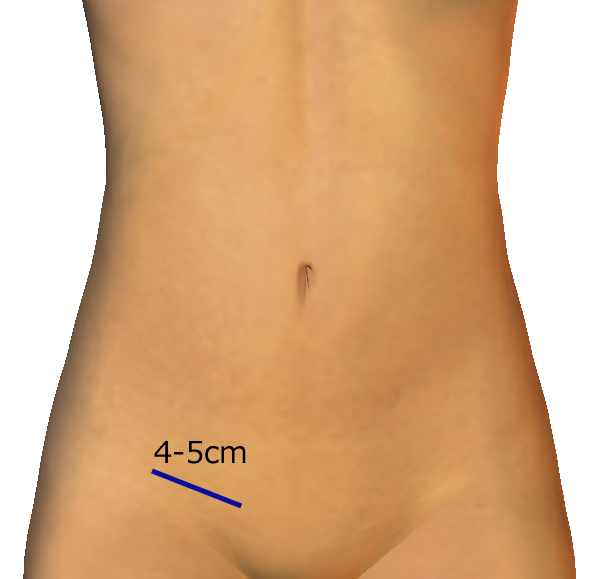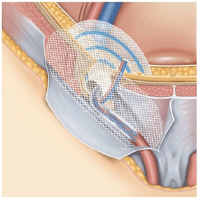
Hernias in women
Consultations
Why do women develop hernias in the inguinal area?
The word “hernia” indicates a condition in which organs and other tissues do not remain in their original location inside the body, but are protruding through a weak area in the muscular wall to form a bulge under the skin.
An abdominal hernia is normally prevented from developing by the action of the fascia and aponeurosis attached to back of the muscles forming the abdominal wall.
If the metabolism of the underlying fascia and other tissues become defective, the muscles and tendons will weaken, and a hernia can develop at such a weak spot.
The risk of having to undergo surgery for inguinal hernia in one’s life is said to be 27.2% for men and 2.6% for women.
Although women are less likely to develop inguinal hernias than men, approximately 20,000 women undergo inguinal hernia repair surgery every year in Japan.
On the other hand, femoral hernias, which resemble inguinal hernias, are more frequent in women than in men, and since these often lead to emergency surgery, surgical repair at an early stage is strongly recommended.
Characteristics of inguinal hernias in women
Compared to inguinal hernias in men, those in women are characterized by being more likely to occur in association with femoral hernias at the same time. Femoral hernias are also more frequent in women, and are more likely to lead to emergency surgery. Women also may have one of the following conditions that resemble hernias very closely. The treatment differs depending on the actual pathology that is present.
Cyst of the canal of Nuck
A cyst or hydrocele of the canal of Nuck is a condition that closely resembles inguinal hernia, and is mostly seen in young women. Fluid accumulates inside the remnant of the canal of Nuck that normally develops in the inguinal canal of a female fetus, but disappears after birth. A bulge can be felt from the inguinal area to the external genitalia that cannot be reduced or pushed back into the body by applying pressure to it. It is known to contain endometriosis in approximately half of all cases. It is accompanied by pain, and although extremely rare, it may become malignant.
External endometriosis
External endometriosis may develop inside the inguinal canal, along the round ligament that supports the uterus, or in a cyst of the Canal of Nuck. Besides showing the symptoms of an inguinal hernia, or a cyst of the canal of Nuck, it is also accompanied by pain related to the menstrual cycle.
Round ligament varices (RLV, varices of the round ligament of the uterus)
The round ligament is a ligament that is connected to connective tissue surrounding the uterus and the labia majora, and it supports the uterus. During pregnancy, varices around the round ligament may cause swelling in the groin that resembles an inguinal hernia. If the blood inside the varices solidifies, it is also painful. This condition usually disappears spontaneously after childbirth, and surgery is only rarely necessary.
Pregnancy-related bulging
The possibility of developing an inguinal hernia during pregnancy is 1 in 2000. As the uterus increases in size during the second and third trimesters of pregnancy, it covers the inguinal canal, so it is very rare for an inguinal hernia to become incarcerated and require emergency surgery. As the woman’s stomach enlarges during pregnancy and abdominal pressure increases, some women may develop an umbilical hernia or an abdominal hernia due to weakening of the abdominal muscles as separate entities from inguinal hernia.
Can an inguinal hernia in a woman heal spontaneously?
No, an inguinal hernia in an adult cannot heal by itself.
The only treatment available is surgical repair.
What happens if an inguinal hernia in an adult woman is not treated (surgically)?
There are no reports of following inguinal hernia in adult women without performing surgery, therefore we do not clearly know what will happen if it is not treated.
However, we do know that women are more likely to need emergency surgery than men.
It is sometimes very difficult to accurately diagnose inguinal and femoral hernias before performing surgery, but since it is known that women are more likely to need emergency surgery, and that femoral hernias occur more frequently in women, we recommend surgical repair of all hernias in the groin area of women in principle.
Which treatment methods are available?
Compared to men, women who have an inguinal hernia are more prone to simultaneously develop a femoral hernia too, so it is recommended to undergo treatment for both.
【1. Using the patient’s own tissue to repair the hernia】
With this treatment method, a patient’s own tissue is used to repair the weakened area by stitching it.
One advantage of this method is that infection is less likely to develop than with a synthetic membrane (mesh) patch since the patient’s own tissue is used.
A disadvantage of the method, however, is that already weakened tissue in the area is used for the surgery, increasing the possibility of recurrence, and patients also may have stronger post-operative pain that lasts longer.
This classical method is presently only used under very special circumstances.
【2. Using synthetic mesh to repair the hernia】
With this treatment method, the weakened part of the abdominal wall is reinforced using a synthetic membrane (mesh) patch made of material that does not cause any problems when implanted in the human body.
Advantages of this method include a low incidence of recurrence of hernia and relatively mild post-operative pain.
Disadvantages include higher susceptibility to infection than when the patient’s own tissue is used, and post-operative pain that may rarely continue for a long time.
Surgical repair using synthetic mesh has become the current mainstream method of treating inguinal hernias in adult women, and almost all cases are treated this way.
Surgical procedures using synthetic mesh are largely divided into two types: open repair and laparoscopic repair.
Open inguinal method of making an incision through the skin covering the bulge of the hernia to repair it


Synthetic mesh is used to repair the weak part through the abdominal incision.
The hernia is repaired from outside the body.
Laparoscopic repair by making small incisions at some distance from the hernia

Three small incisions are made in the abdominal wall, and special surgical instruments are inserted through these openings to do the repair.

Special surgical instruments are inserted through the openings and a synthetic mesh patch is used to repair the defect.

The hernia is repaired from inside the body.
Which method of repair is better?
The best procedure for every patient depends on the patient’s general physical condition and the past medical history, and differs for every case.
Hernia specialists will determine the best treatment based on every patient’s individual situation.
Please see P75 “Adults - Treatment of Special Patients – Women (Including pregnant patients)” of the 2015 Inguinal Hernia Treatment Guideline of the Japan Hernia Society, for the general treatment methods available.
In Japan there is not an official certification system for hernia repair techniques, but certification is available for laparoscopic hernia repair, and of the only 66 surgeons who have received certification as of July 2017, two are performing laparoscopic hernia repair procedures at this center on a full-time basis.
